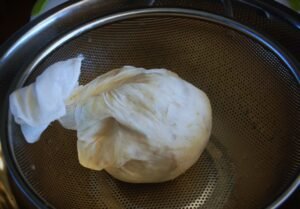By Jim Hingst
Potato
pancakes or latkes are not just for special occasions. They are also great as a
breakfast side dish. During the Depression they were a popular and inexpensive
meal. Here’s a recipe that my Polish grandmother would make for me when I was a
young boy.
Ingredients
2
pounds russet potatoes (you can also use Yukon gold or baking potatoes)
NOTE: the
reason that russet potatoes are used is that the moisture content is lower and
the starch content is higher. Waxier potatoes with a higher moisture content
will not fry up as crispy.
1
medium onion
1
grated carrot (optional)
2
large eggs, beaten
1
tsp. salt
freshly
ground pepper
1/3
cup matzo meal (if you don’t have matzo meal you can substitute Panko bread
crumbs or all-purpose flour)
1 teaspoon
baking powder
Neutral
vegetable oil or Crisco for frying
Directions
In
making latkes you can use russet potatoes with or without the skins. If you peel
the potatoes and put them in ice cold water. Grate the potatoes, carrot and
onions using a box grater. If you decide to grate the potatoes with the skins
on make sure that you thoroughly wash the outer surface of your spuds.
The
skin of the potato is a great source of vitamins B and C as well as other
essential nutrients such as calcium, phosphorus, manganese, copper and
potassium. The skins also provide your diet with fiber.
In
grating your potatoes, the grind or coarseness that you select is really a
matter of personal preference. My grandmother preferred a finer grind. On the
other hand, I prefer a coarser texture. For this reason, I use the coarse holes
for the potatoes and the fine ones for the onion.
Place the gratings in a bath of ice water as you are working to prevent the
potatoes from oxidizing and turning brown. Soak the grated potatoes for ten minutes. See below.
When
you are finished grating the potatoes and onion, transfer the mixture in
a colander lined with cheesecloth. See the picture below.
Cover the grated mixture with another towel and allow the water to drain for a few minutes. Capture the
drippings in a bowl underneath the colander. Wrapping the potato mixture with the
cheesecloth, squeeze out any remaining water as best you can. See the photo below. Excess moisture
in your mixture will prevent the latkes from crisping up properly so this step
is critical.
You should
save the ice water from grating’s bath and capture the strained liquid. Allow
the potato starch in the water to settle to the bottom of the bowl. Drain off
the liquid leaving the collected starch. You can add the potato starch into
your grating’s mixture. The starch will act as an adherent to bind the other
ingredients together so your latkes don’t fall apart.
Mix
the potato and onion with the matzo meal (or AP flour) and baking
powder. The baking powder will help make the exterior of latke crispy while the
interior will be fluffier. Add the beaten egg, and salt and pepper. The egg
acts as a binder for the batter. For a more
fluid texture add an extra egg. For a stiffer texture or if the mixture is too
runny, add some matzo meal or all-purpose flour to the batter. The desired
consistency of the batter is a matter of personal preference.
In the
frying pan heat the vegetable oil or Crisco (shortening) to 385⁰F. Crisco is
great for frying and today’s formulation is free of trans fats so you don’t
need to worry about your arteries clogging. Some traditionalists opt for using
chicken or duck fat. Whatever you use, use enough oil or shortening to be deep
enough to equal half the thickness of the pancake. Half an inch to an inch of
oil should do the trick.
If
your mixture is firm, you can form the latkes into balls with your hands and
then flatten them out with the back of a spatula. If the batter is more fluid,
use a ¼ measuring cup to ladle out the mixture.
Fry
until golden brown on both sides. It usually takes 3 to 4 minutes on each side
to fry the pancakes. Allow sufficient spacing between pancakes when frying to
prevent them from getting soggy. Keep in mind that each time you add patties to
your pan the temperature of the oil will drop. This increases the time that the
pancakes need to cook in which the interior of the will can become more
saturated with oil.
To
facilitate turning the latkes use a fish spatula. The flexibility of this type of spatula makes flipping
pancakes easier and makes splattering scalding hot oil less likely. If your
latkes are small, you can also use tongs to flip them.
After
your latkes are fried, you can place them on a platter lined with paper towels
to soak up the excess oil. Better yet use a wire rack over a cookie sheet to
facilitate the draining of oil. See the photo below. Put the
cookie sheet in an oven set at 200⁰F to keep the potato pancakes warm before
serving. Serve the fried latkes with sour cream or applesauce or both.
If
you have leftovers, you can store them in your fridge for a few days. To reheat them, can refry the latkes in a
frying pan with a little oil until the internal temperature of the pancake is
165⁰F. Reheating in a microwave however is not recommended. You can also reheat
the latkes in the oven. Preheat your oven to 350⁰F. Place the leftover latkes
on a cookie sheet and heat for 10 minutes. Flip the pancakes and reheat for
another 10 minutes.







